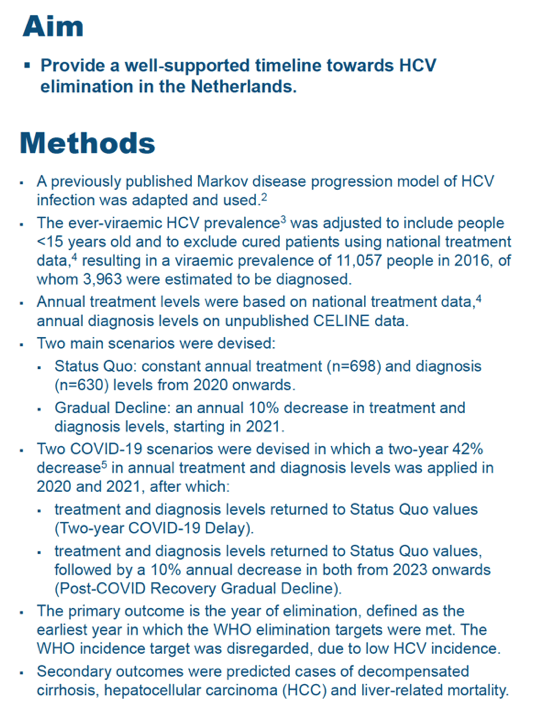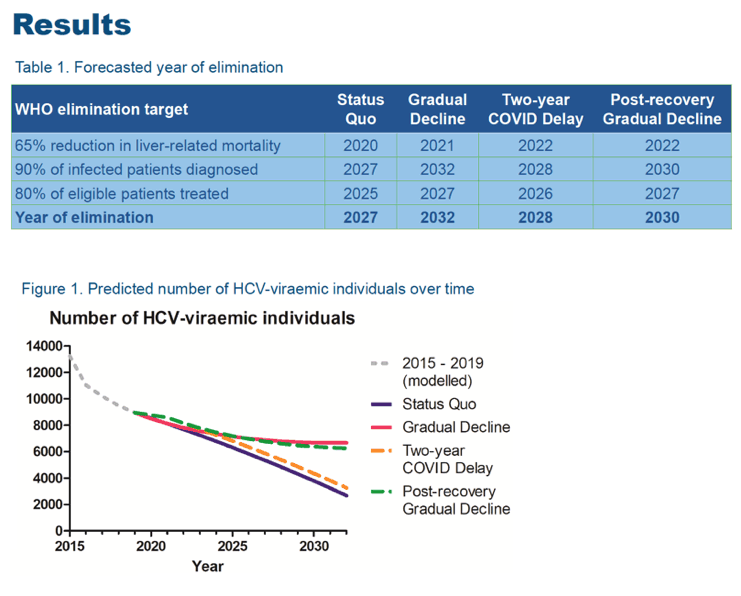 |
 |
 |
| |
Anticipated timing of hepatitis C virus
elimination in the Netherlands and the
impact of COVID-19
|
| |
| |
EASL International Liver Congress, June 23-26, 2021
Marleen van Dijk1, Sylvia Brakenhoff2, Cas J. Isfordink3,4, Wei-Han Cheng5, Robert De Knegt2, Sophie Willemse6, Marc van der Valk, Joost Ph Drenth. Radboudumc, Gastroenterology and Hepatology, Nijmegen, Netherlands; 2Erasmus Medical Centre, Rotterdam, Netherlands;
Gastroenterology and Hepatology, Utrecht, Netherlands; 4Amsterdam Infection and Immunity Institute, Amsterdam University Medical Centre, Amsterdam, Netherlands; 5Abbvie Pharmaceuticals, Health Economics and Outcomes Research, Chicago, United States; 6Amsterdam University Medical Centre, Gastroenterology and Hepatology, Amsterdam, Netherlands

from abstract
Background and aims: The Netherlands has committed itself to eliminate hepatitis C virus (HCV) infection, according to the World Health Organization (WHO) elimination targets. A recent analysis suggested that elimination will only be reached by 2035 in the Netherlands. Recently, a nationwide HCV elimination project (CELINE) has harvested new data on the Dutch HCV epidemic. Therefore, this study aims to provide an updated analysis on elimination progress in the Netherlands.
Method: A previously published Markov model was used to map the path to HCV elimination. Prevalence data from 2016, treatment data from 2000-2019 and unpublished CELINE data were used as inputs. In the "Status Quo" scenario, we assumed a 10% decrease in diagnosis and treatment levels in 2020, as compared to 2019. From 2021 onwards, diagnosis and treatment levels stayed constant. In the "Gradual Decrease" scenario, starting in 2020, we assumed an annual decrease of 10% in both diagnoses and treatments. Finally, a two-year delay in elimination as a result of COVID-19 was modelled. We assumed a decrease of 42% in both diagnosis and treatment levels for 2020 and 2021. We anticipated that these levels would either rise again to "Status Quo" values in 2022 and remain constant afterwards ("Two-year COVID-19 Delay"), or would increase to "Status Quo" values in 2022, followed by an annual decrease of 10% ("Post-recovery Gradual Decrease"). WHO mortality, diagnosis, and treatment targets for 2030 were considered; the incidence target was disregarded, due to the very low incidence in the Netherlands (≤5 per 100, 000).
Results: Following the "Status Quo" and "Gradual Decrease" scenarios, the Netherlands would reach the WHO targets by 2027 and 2032, respectively. The "Two-year COVID-19 Delay" would result in elimination by 2028, and the "Post-recovery Gradual Decrease" scenario would result in elimination by 2030 (see Table). The annual number of treatments needed in 2020-2030 was 381.
Conclusion: The Netherlands is on track to reach HCV elimination by 2030. COVID-19 does not seem to have a profound impact on the WHO HCV elimination goals. This might be because HCV incidence is so low and because the threshold of 381 annual treatments is more than met in the majority of years. It is, however, vital that HCV elimination remain high on the agenda.




|
| |
|
 |
 |
|
|